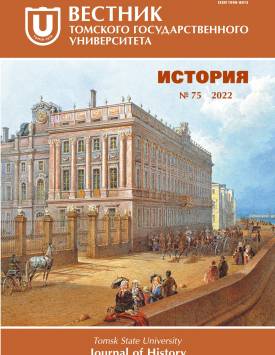Alcohol issue in Siberia on the eve and during the First World War (1914-1918) and its perception by the local officials
In the article the authors aim at sketching out the situation with the production of home brew in the region during the First World War (1914-1918) and the provincial authorities’ ensuing reaction. This task has been completed for the most part by the use of such sources as the governors' reports and accounts found in the fonds of the Special Section of the Police Department of the MVD (Ministry of Internal Affairs) in the State Archive of the Russian Federation. The collected data has been analyzed using the comparative historical and structural-functional methods. The small-scale process of alcohol abuse became more noticeable during mobilization and transportation of the drafted reservists at the early stage (from July, 19 to the beginning of August, 1914) of the First World War (1914-1918). In the long term, the prolonged war led to the large-scale preparation and, as a consequence, consumption of home brew and surrogate alcohol, produced in amateurish way, especially in the rural areas. On July, 19, 1914 sales of strong alcoholic drinks were officially banned for the period of general mobilization. This ban was extended until the end of the war according to the decree from August, 22 of the same year. On September, 27 and October, 13, 1914 the Council of Ministers authorized the local self-government bodies to ban the wine and beer sales completely. Introducing the "dry law», the local authorities presented it as a panacea. However, the ban of strong drinks sales led to the large-scale production of home brew. As a result, since 1915 the bootlegging had been an issue of constant concern in the governors’ repo rts. In the region, there existed all reasons for the intensification of this process. Peasants used grain that had not been sold in the market due to the suspension of exports as a feedstock. For the construction of wine distilleries, they had all necessary "technological" equipment: heating spirals, metal containers (cauldrons, buckets, water tanks). In spite of the undertaken measures home brew making increased. As the illegal alcohol-distillation spread and counter-measures of authorities became more active the resistance of those who violated dry law also intensified and included even the use of firearms and the killing of the policemen, witnesses, village policemen and constables (desyatskye and sotskye). According to the information from the senior officials of the Yeniseysk province, the majority of bootleggers were from among the exile settlers and resettlers. Acknowledging their own weakness local authorities started to ask the government to increase penalties for home brew and to enlarge the number of police personnel. Officials believed that the most effective tool in suppressing the bootlegging was to refer such cases to the military courts and try them according to wartime laws. The authors believe that the situation with the production and use of moonshine in Siberia worsened with the outbreak of the First World War of 1914-1918. The alcohol issue, along with other factors of internal order and military failures, contributed to the strengthening of the systemic crisis of imperial Russia.
Keywords
pub, samogon, home brew, "dry law", illegal alcohol-distillation, wine distilleryAuthors
| Name | Organization | |
| Shilovskiy Denis M. | Novosibirsk State University of Economics and Management | awlsome@gmail.com |
| Shilovskiy Mikhail V. | Novosibirsk National Research State University; Institute of History of the Siberian Branch of the Russian Academy of Sciences | istorik.novosib@gmail.com |
References

Alcohol issue in Siberia on the eve and during the First World War (1914-1918) and its perception by the local officials | Tomsk State University Journal of History. 2022. № 75. DOI: 10.17223/19988613/75/11
